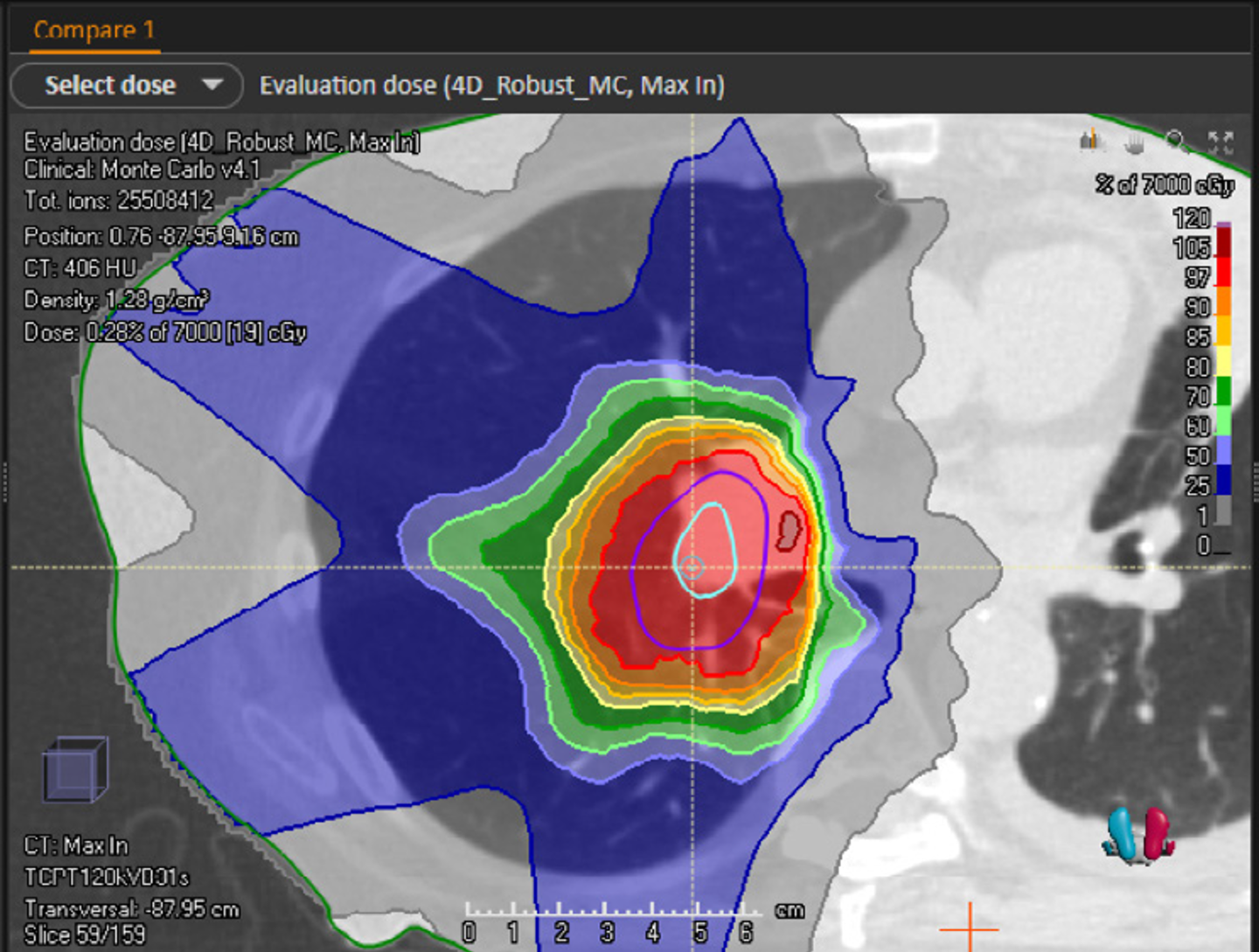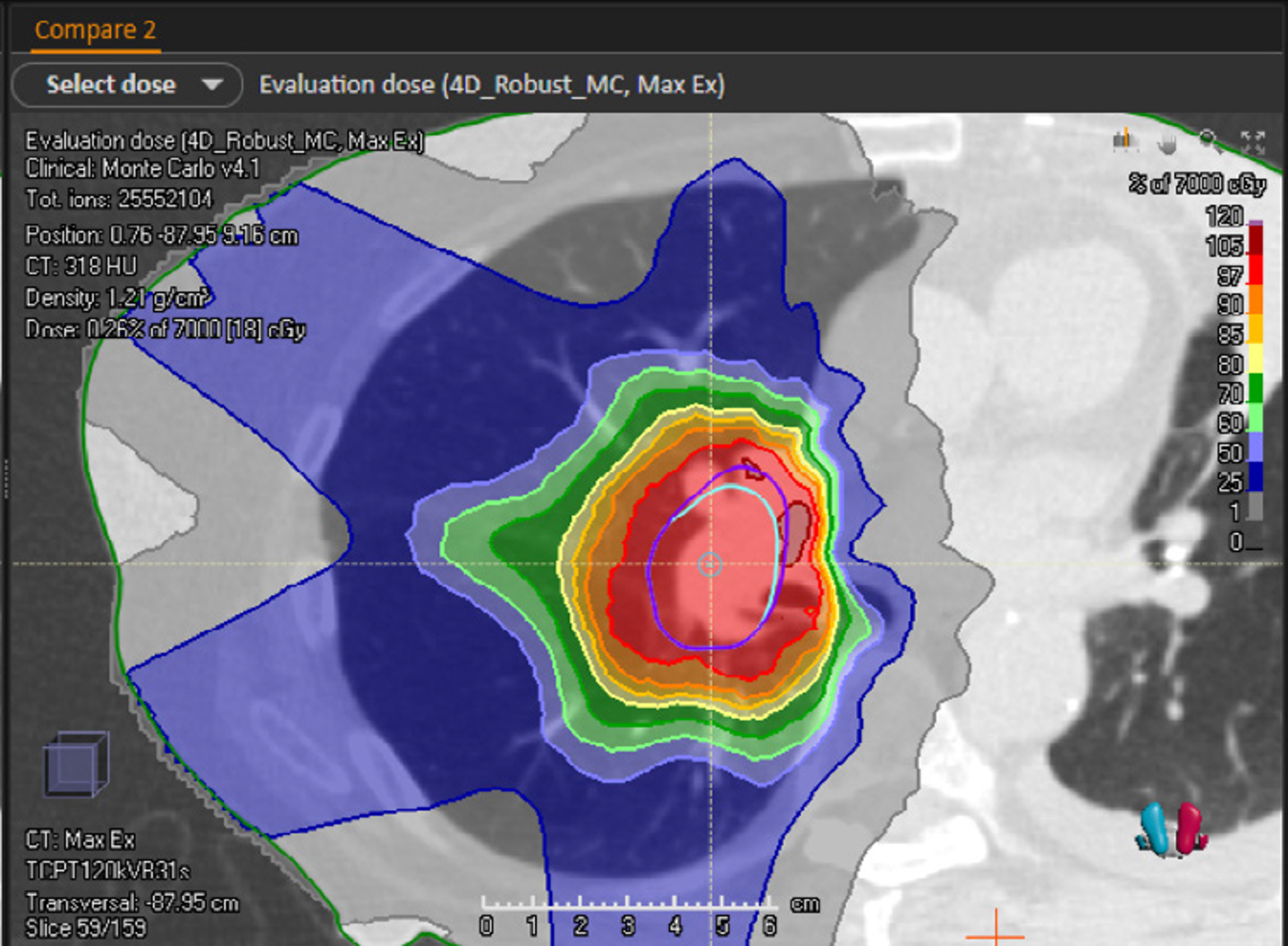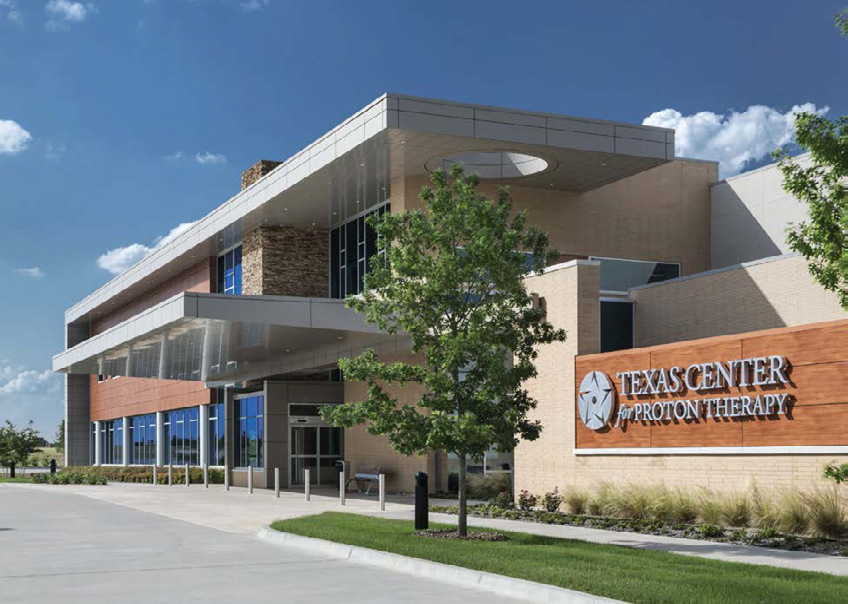The implementation of treatment planning with 4D-robust optimization and Monte Carlo dose calculation in RayStation, combined with automated volumetric-repainting beam delivery developed at Texas Center for Proton Therapy, allows us to treat lung patients and other moving targets using PBS in a safe and efficient manner. In fact, approximately 15 percent of our current patients are now treated using these techniques.”

Case study: Texas Center for Proton Therapy
A COMPREHENSIVE APPROACH TO LUNG TREATMENT

Lung cancer treatment is a particular focus, and the center has developed a comprehensive program based on the latest technology and clinical techniques, including proton pencil beam scanning (PBS).
“Thorax and liver treatment represents more than 17 percent of our current patients (14 percent thorax and 3 percent liver). Treatment of tumors with large respiratory motion such as those in the lungs and liver with PBS has been a particular challenge”, says Dr. Andrew K. Lee, Medical Director of Texas Center for Proton Therapy. “However, the implementation of treatment planning with 4D-robust optimization and Monte Carlo dose calculation in RayStation, combined with automated volumetric-repainting beam delivery developed at Texas Center for Proton Therapy, allows us to treat lung patients and other moving targets using PBS in a safe and efficient manner. In fact, approximately 15 percent of our current patients are now treated using these techniques.”
High precision and motion management
Treating lung cancer with radiation therapy can be challenging due to the proximity to critical structures and surrounding healthy lung tissue. The precision of proton therapy – and PBS in particular – enables much more conformal radiation, with higher doses delivered to tumors and lower doses to healthy tissues.
There are many advantages to proton therapy, but its extreme precision brings its own challenges. The steep dose gradients that enable the sparing of healthy tissues could also potentially result in inhomogeneous dose distribution due to intra-fractional tumor motion. This effect can potentially lead to underdosing of the tumor and/ or overdosing of organs at risk. Strategies to resolve these issues include inter- and intra-fractional tracking, improving immobilization or employing motion-mitigation techniques such as breath-hold, gating, repainting and 4D optimization. For free-breathing treatments, the motion of the target and surrounding tissues must be considered during treatment planning. Furthermore, the variable densities in the thorax require that the dose be calculated with advanced algorithms.

Systematic workflow
The center’s program is based on a clearly defined workflow for all activities within imaging, planning and treatment delivery. The workflow is outlined below.
Imaging
Patient imaging is done using a large-bore CT with PET capability, and respiratory motion is tracked by an external surrogate using the Anzai laser system.
The Anzai system is directly connected to the CT and provides a respiratory motion curve to the imaging device. While in 4D acquisition mode, the CT uses this information to automatically associate the different CT phases, based on the percentage of motion amplitude, to create the different 4D binning phases that will be used to reconstruct a 4D CT.
The radiation oncologist validates the quality of the reconstructed 4D CT, and tumor motion is then evaluated. This evaluation will then be used to determine whether a free-breathing treatment or a deep-inspiration breath hold treatment is needed. In the latter case, a new CT is acquired with the patient in deep-inspiration condition, using the Anzai system with patient feedback to ensure the correct and consistent level of deep inspiration.
Planning
For free-breathing treatments, the dosimetrist generates PBS plans that are optimized using the 4D-robust planning functionality in RayStation. “4D-robust” plans refer to the fact that the plans are optimized over multiple respiratory phase scenarios, assuring that motion, as well as setup and density uncertainties are considered in the development of the treatment plan. This reduces the sensitivity of the plan and improves the delivery of the proper dose to the tumor and healthy tissues.
For the 4D-robust lung plans, the CT data from the maximum, minimum, mean, and one of the intermediate breathing phases are used. Both layer and volumetric repainting are incorporated to reduce the interplay effect with PBS1. A detailed validation of this method has been summarized in a paper submitted to Int. J. Particle Therapy2. For the treatments gated by breath-hold, regular 3D robust plans are created on the planning CT taking setup and range uncertainties into account.
Dose calculation is performed with the RayStation Monte Carlo dose engine, which has proven to be accurate for challenging lung cases where traditional analytical dose engines may fail1,3. The Monte- Carlo algorithm is used in the 4D-robust optimization and for the final dose calculation.
RayStation’s extensive scripting capabilities make it possible to utilize IBA’s advanced beam delivery system to the fullest extent. The center’s physics team developed a custom script that allows the user to define the number of volumetric repaints individualized to each case. Essentially, the script generates a plan that delivers the prescription using automated volumetric repainting.
Treatment
The treatment consists of 3 major steps:
- Patient selection in the oncology information system (OIS): The data needed to set up, align and deliver beams to the patient are defined in RayStation and transferred to the OIS for delivery.
- Patient alignment: Using the IBA adaPT imaging and treatment system, CBCT and orthogonal images are acquired to align the patient. In case of deep inspiration breath hold, an initial breathhold is used to align the patient using orthogonal kV. Another one to two breath-hold(s) is then used to verify patient alignment using CBCT, after which the beam can be delivered.
- Beam delivery: Using the adaPT treatment suite, pencil beam scanning is delivered using both layer and volumetric repainting1. The typical irradiation time is between 30 seconds to 3 minutes, depending on tumor size. Two to four volumetric repaints are used in all thorax cases. Volumetric repainting increases the total irradiation time, but this is negligible for smaller tumors.
Conclusion
Moving targets pose a unique challenge in proton therapy, especially for pencil beam scanning. However, advanced technology has enabled Texas Center for Proton Therapy to implement a comprehensive and highly effective treatment program, including CBCT, 4D-robust optimization, automated volumetric repainting and breath hold. Planning capabilities are central to the center’s approach, and RayStation’s features such as 4D-robust optimization with Monte Carlo dose calculation algorithm, scripting capabilities and an efficient workflow have played key roles.


4D-robust optimized three field lung plan with dose recomputed on the maximum inhale (above) and maximum exhale (below) breathing phases. The CTV in each image is depicted as a light blue line, and an ITV (purple) is included in both images to demonstrate the motion of the CTV. Optimization and final dose computation was performed using the MC dose engine in RayStation.
References
- Clinical Validation of Proton Pencil Beam Scanning on an Anthropomorphic Lung Phantom. P. Wang et al., Accepted for publication in Med Dosim.
- Four-Dimensional Plan Optimization for the Treatment of Lung Tumors Using Pencil-Beam Scanning Proton Radiotherapy. D. Cummings, et al., submitted to Int J Part Ther.
- Pencil Beam Algorithms Are Unsuitable for Proton Dose Calculations in Lung, P. Taylor et al., Int J Radiat Oncol Biol Phys. 99 (2017) p. 750-756
ADVANCING CANCER TREATMENT
RaySearch is a committed pioneer of software for radiation therapy. Software has unlimited potential for advancing cancer treatment, and we believe it is now the driving force for innovation in radiation therapy. Medical science never stands still, and neither does RaySearch. Since 2000, we have worked in close cooperation with leading cancer centers to advance cancer treatment. We are not just a software vendor – we are an innovation partner. RayStation®, our next-generation treatment planning system, supports the quality of decision-making, creates new treatment possibilities and gets maximum value from existing equipment. By making treatment planning faster, easier and more flexible, we enable better care for cancer patients worldwide.
And this is just the beginning.
For more information or to see a demo, contact sales@raysearchlabs.com
